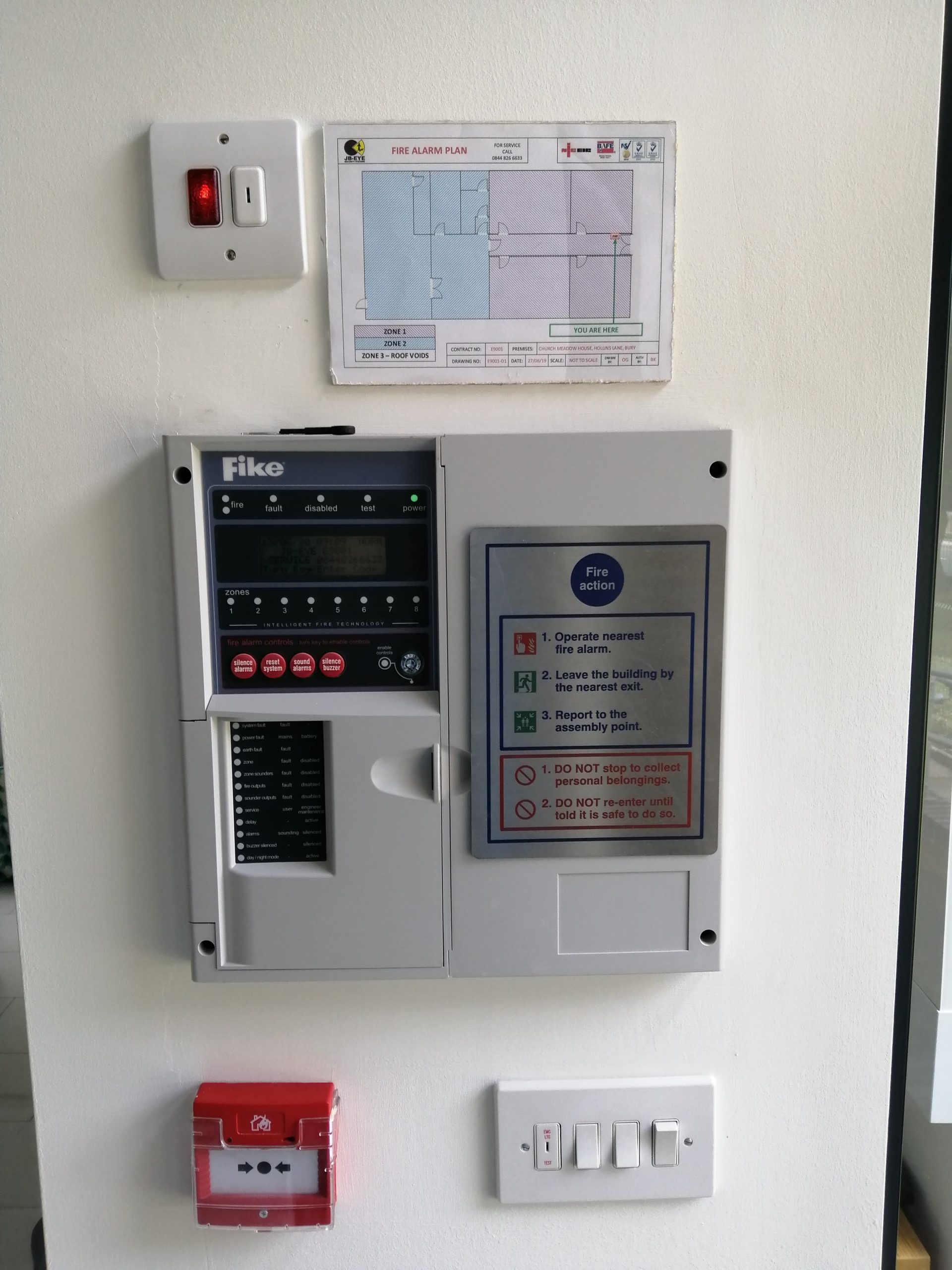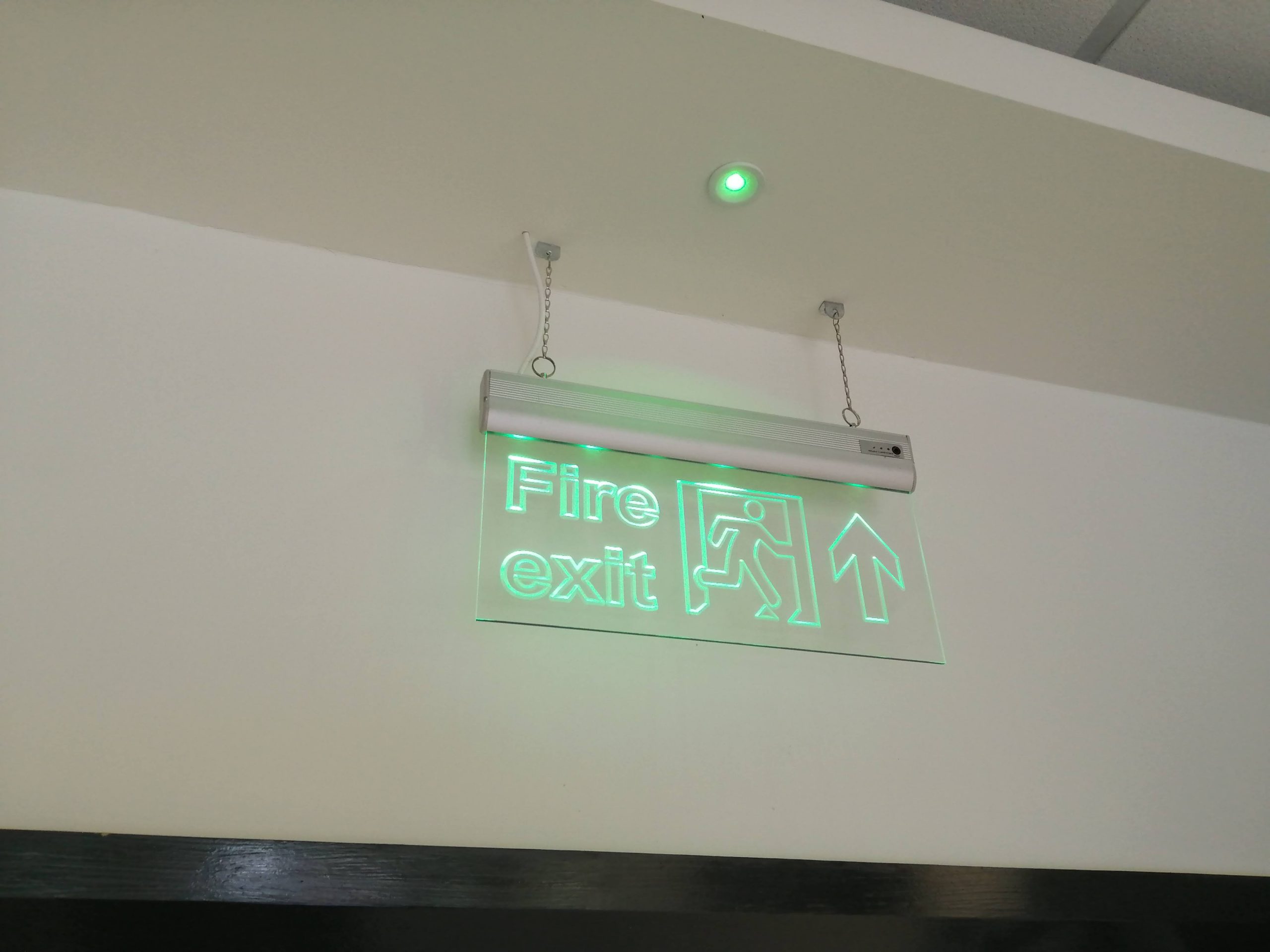installation – takeover – maintenance – monitoring.
Maximise Investment – Minimize Ongoing Cost
Intruder Alarms
LEARN MORE
CCTV
LEARN MORE
Access Control
LEARN MORE
Fire Alarms
LEARN MORE
Emergency Lighting
LEARN MORE
Site Audio Alert
LEARN MORE

A fire alarm is vital equipment to protect your business, not only can it help protect your premises from fire it can also save lives. Therefore it is essential that your alarm works correctly – having a fire alarm is not enough if you cannot be sure that it will work when you need it.
We can install and maintain a fully comprehensive fire alarm systems, from design through to commissioning, or we can maintain an existing alarm system within your premises, providing a detailed report on our initial instruction to act as the maintainer.
From design and installation to upgrades and ongoing maintenance services, we can offer any level of service support you require to ensure your fire alarm meets current regulations.
Why should you consider a monitored fire detection system?
Could your company survive a fire? or would it be one of the 54% of businesses which never recover?
Fire doesn’t discriminate. It hits anything from hospitals to retail outlets, factories to schools, residential or industrial. Everyone is at risk. There are ways of protecting yourself and your property.
Example Scenario
Your property contains irreplaceable data, sales and purchase ledgers, accounts, customer details, tools and machinery. The building’s electric’s are strained. Eventually they submit and it’s here your nightmare begins. At first it’s just a cable but soon the flames take hold and begin to spread. Smoke is about to trigger your alarm.
The outcome for premises without monitoring
At 2.00am the audible fire alarm sounds. At 2.35am the fire is devastating the building and woken some local residents who have called the fire brigade. By 6.30am the building, and your business, have literally gone up in smoke. At first your customers are sympathetic but soon their own needs take over and they begin to look elsewhere.
See the outcome for premises with monitoring
At 2.00am when the smoke triggers the alarm a signal is sent from your alarm panel to our Alarm Receiving Centre and the fire brigade are dispatched. At 2.15am the fire service has gained entry to the building and confined the fire to a small area limiting the damage. By 6.30am am the building and more importantly your business are still standing. The whole process from the alarm being raised to dispatching the Fire brigade takes only seconds and because all the systems are continuously monitored any system failure can be investigated.
By choosing JB-EYE to maintain their fire alarms our clients are seen to be acting highly responsible with regards to the safety and welfare of their employees whilst keeping abreast of all revisions and modifications to the national and local fire codes and addressing their continually changing requirements.
How do fire alarm systems work?
All fire alarm systems work on the same basic principle. If someone operates a manual call point or a detection device is activated by smoke or heat then the alarm sounders are activated to alert people in the premises of a potential fire. A fire alarm system that incorporates remote signalling will also alert a remote monitoring station who can notify key holders and request fire brigade attendance.
What types of fire alarm system do JB-EYE offer?
Conventional Systems – A conventional fire alarm system is generally suitable for small to medium size premises. The fire alarm system will typically be segregated into separate zones (areas) although in some very small systems the whole premises may be one single zone. When any device is activated sounders throughout the premises will ring. The control panel will indicate which zone has activated. On systems with multiple zones this allows nominated fire marshals to tailor evacuation accordingly and for the fire brigade to narrow down their search for a fire to a particular area of the premises. Where faults occur the control panel will indicate the affected zone allowing maintenance staff to narrow down fault finding.
Addressable Systems – An addressable fire alarm system is generally suited to a medium to large size premises and operates on the same principal as a conventional system, however the primary difference is the control panel is able to report the exact device that has triggered the alarm. By having this extra information nominated fire marshals can make much more informed decisions about how to evacuate a premises and responding fire brigade staff can go directly to the point the fire has been reported from. Where faults occur the control panel will indicate the affected device allowing maintenance staff to very quickly narrow down fault finding. The intelligent nature of the equipment also allows a much more varied approach to fire actions procedures possibly including phased alarms or links to other systems.
What are your legal responsibilities?
Fire Regulation in England and Wales is governed by the Regulatory Reform (Fire Safety) Order 2005. In England and Wales, if you’re an employer, owner, landlord or occupier of business or other non-domestic premises, you’re responsible for fire safety and are known as the ‘responsible person’.
Shared premises: In shared premises it’s likely there’ll be more than one responsible person. You’ll need to coordinate your fire safety plans to make sure people on or around the premises are safe. For common or shared areas, the responsible person is the landlord, freeholder or managing agent.
As the ‘responsible person’ you must:
- carry out and regularly review a fire risk assessment of the premises
- tell staff or their representatives about the risks you’ve identified
- put in place, and maintain, appropriate fire safety measures
- plan for an emergency
- provide staff information, fire safety instruction and trainingIf your business employs 5 or more people you must maintain a written fire risk assessment
Non-domestic premises are:
- all workplaces and commercial premises
- all premises the public have access to
- the common parts of multi-occupied residential buildings
What category of fire alarm system do I need?
The first decision to be made when considering a fire detection system is a simple choice of establishing the purpose of the system, that is whether it is for protecting the building, its contents and business continuity (Property Protection) or enhancing the safety of the occupants (Life Protection). British Standard BS 5839-1: 2017 categorises systems according to their purpose and the extent of protection to be afforded.
Manual (Category M)
If it is determined that there should be no automatic detection, a simple system comprising sounders and break glass call points alone might suffice. This type of system is described as a Category M system.
Clause 5 of the code divides systems that incorporate automatic fire detection into two main Categories, according to whether the objective is life safety (Category L) or property protection (Category P). The two Categories are then further sub-divided, according to the extent of coverage by automatic fire detection.
Life Protection (Category L)
This classification provides for the protection of life, that is the safety of the occupants. It caters for the detection of a fire, initiates an alarm of fire, and provides sufficient time for the occupants to escape from the building.
Category L5: The protected area and/or the location of detectors is designed to satisfy a specific fire safety objective. This may be defined in a fire engineering solution or from a fire risk assessment.
Category L4: Covers those parts of the escape routes comprising circulation areas and circulation spaces, such as corridors and airways.
Category L3: Covers escape routes and rooms opening onto escape routes (detectors may be situated adjacent to the door onto the escape route).
Category L2: Covers the areas protected by Category 3 system plus other areas where it is considered that there is a high fire hazard and/ or fire risk.
Category L1: Total coverage throughout the building.
Property Protection (Category P)
This classification provides for the protection of property and its contents. It caters for the automatic detection of a fire, initiates an alarm of fire, and results in summoning of the fire brigade (which may be by a means of automatic transmission of fire signals to an Alarm Receiving Centre).
Category P2: Covers areas of high fire hazard or high risk to property or business continuity from fire.
Category P1: Total coverage throughout the building.
JB EYE can offer individually tailored advice on the fire alarm system most suited to your requirements.
Like all electronic security CCTV technology rapidly advances, new features and functionality with technical jargon can overwhelm when trying to decide on what will best suit your requirements.
We fully understand the need to keep within a budget and achieve maximum return on investment. By choosing JB-EYE you can be assured that our professional team will make equipment recommendations to suit your specific situation rather than fit generic systems or unnecessary equipment that isn’t of any benefit.
We have carefully selected a standardised range of equipment that provide options from simple standalone on site recording through to remotely monitored systems with the flexibility to upgrade and expand as required.
Remote Access
Access to view both live and recorded footage with system management is available through a wide range of mediums allowing flexibility based on the premises infrastructure and end user requirements. In addition to comprehensive management software remote viewing can be provided via android, iPad and iPhone applications as well as through a standard web browser. Customers with multiple sites can view and retrieve footage from all their systems through one piece of management software allowing for simplified branch management.
CCTV Monitoring
We can provide offsite monitoring of your cctv system. Remote operators will be notified when activity occurs on your site outside your normal schedules and can quickly access your cameras and see if further action is required. This could be notification to your key holding or security guarding company, senior company management or the police in the event of attempted break in or vandalism.
Maintenance
All JB-EYE cctv system contracts include one NSI approved routine service visit per annum. Our industry trained engineers carry out a comprehensive service of your system including:
- Checking the system meets its as-fitted specification
- Checking all visible cabling and fixings
- Cleaning all camera housings
- Checking correct operation of recording and playback
- Checking connection to monitoring station (monitored systems only)
Unauthorised entry to your premises can lead to loss of equipment and proprietary information as well as putting at risk your staff and visitors. JB-EYE provide simple to use systems to regulate access to your premises with functionality that can adapt as your needs grow. Our expert staff will ensure any systems installed comply with current regulations.
JB-EYE access control software works in the background allowing your staff to concentrate on running your business. The system is easy to use and offers a range of advanced functionality that can be activated as your needs change. Reports can be viewed and exported to show access times for individual personnel or particular departments. Access rights can be assigned based on a variety of criteria to allow or restrict access as required either across the whole premises or on a door by door basis.
In many instances JB-EYE access control can work in conjunction with other systems utilising the same keyfobs or cards and can be programmed to work on multisite installations allowing user access across various sites.
The advantages of access control to your business may be as follows:-
- Centrally controlled security
- Anyone without a valid access card or fob is prevented from access
- Avoids complicated management – you can simply delete and re-issue a card/fob
- Stops widespread knowledge of a door entry code or combination
- Helps manage site security with contract or permanent staff who leave
- Enables restricted access, safeguarding equipment and stock
- Restrict car park access to authorised personnel
- Time slots can be set to open doors during pre-determined time periods
- A fire roster can be quickly generated in the event of evacuation
- Improve staff management with reports showing staff movement and time keeping
- Provides on/off-site system management and control
- Mimic drawing showing the status individual doors.
Maintenance
All JB-EYE access control system contracts include one NSI approved routine service visit per annum. Our industry trained engineers carry out a comprehensive service of your system including:
- Checking all access control readers function correctly
- Checking all electronic locks and tightening magnetic lock fixings
- Checking all request to exit buttons function correctly and are in a good state of repair
- Checking all emergency egress equipment functions correctly and are in a good state of repair

Emergency lighting provides illumination for the safety of people leaving a location, or attempting to terminate a potentially dangerous process before leaving, in the event of a failure of the power supply to the normal lighting provision. Emergency Lighting is part of the fire safety provision of a building and a requirement of The Regulatory Reform (Fire Safety) Order 2005.
JB-EYE can survey your premises and use our expertise to advise on your minimum regulatory requirements as well as discussing further protection that you may require. We offer a complete service through quotation, installation and/or takeover and ongoing maintenance.
Operating Modes of Emergency Lighting
Emergency Lights are generally categorised into two modes of operation:
Maintained – a luminaire in which the emergency lighting lamps are illuminated at all times. Maintained mode is generally used in places of assembly such as theatres, cinemas, clubs and halls; the full list is contained in BS 5266. The lights are typically dimmed when these premises are occupied and the emergency escape lighting prevents total darkness.
Non-Maintained – a luminaire whose emergency lamps only illuminate when the power supply to the normal lighting fails. Non-maintained is the typical mode in a workplace or similar environment in which artificial lighting is normally deployed while the premises are occupied.
In new installations, we install low power LED fittings that can be set to either maintained or non-maintained depending on the needs of the premises.
Emergency Light Types
Self Contained Type – each individual fitting has its own local wired power supply and contains a rechargeable back-up battery.
Central Battery Type – All fittings are wired back to one central battery unit.
Lockdown Alert text here
Installation. Takeover. Maintenance. Monitoring.
Our expert team provide management of your security systems needs so you can focus on your core business. From survey and quotation through ongoing routine maintenance and emergency support our knowledge of standards and best practice ensures your business is safe, secure and compliant.
Managed Systems
Our objective is to simplify your workload by providing:
- Simple systems for your staff to use reducing false alarms and corrective visits.
- Preventative maintenance schedules to minimise disruption and ensure your systems work correctly when required.
- Clear and timely reports to ensure you meet your compliance criteria, colour coded for different system types.
- All staff DBS checked & NSI security vetted.
- Point Of Work Risk Assessment for all jobs.

